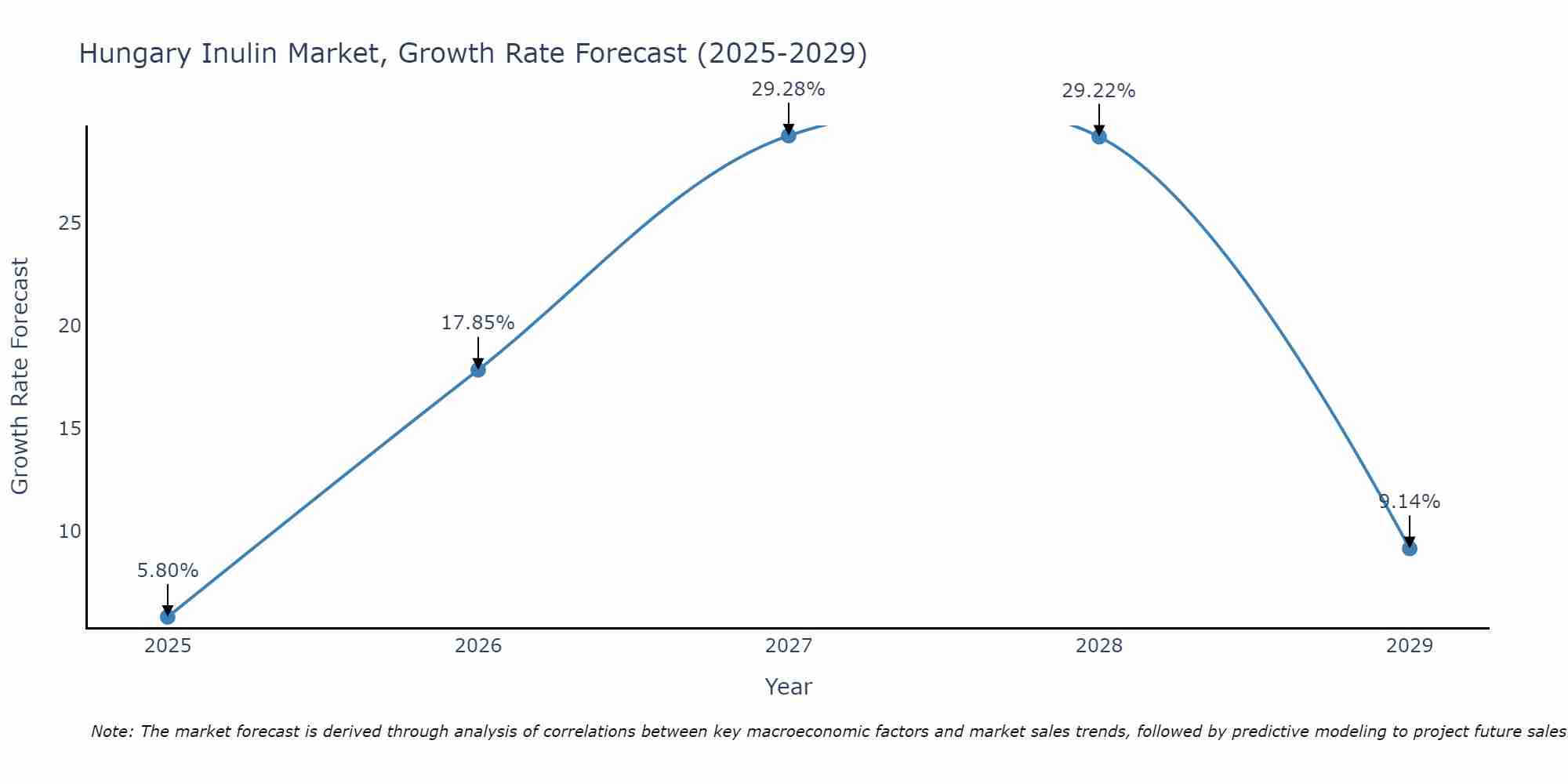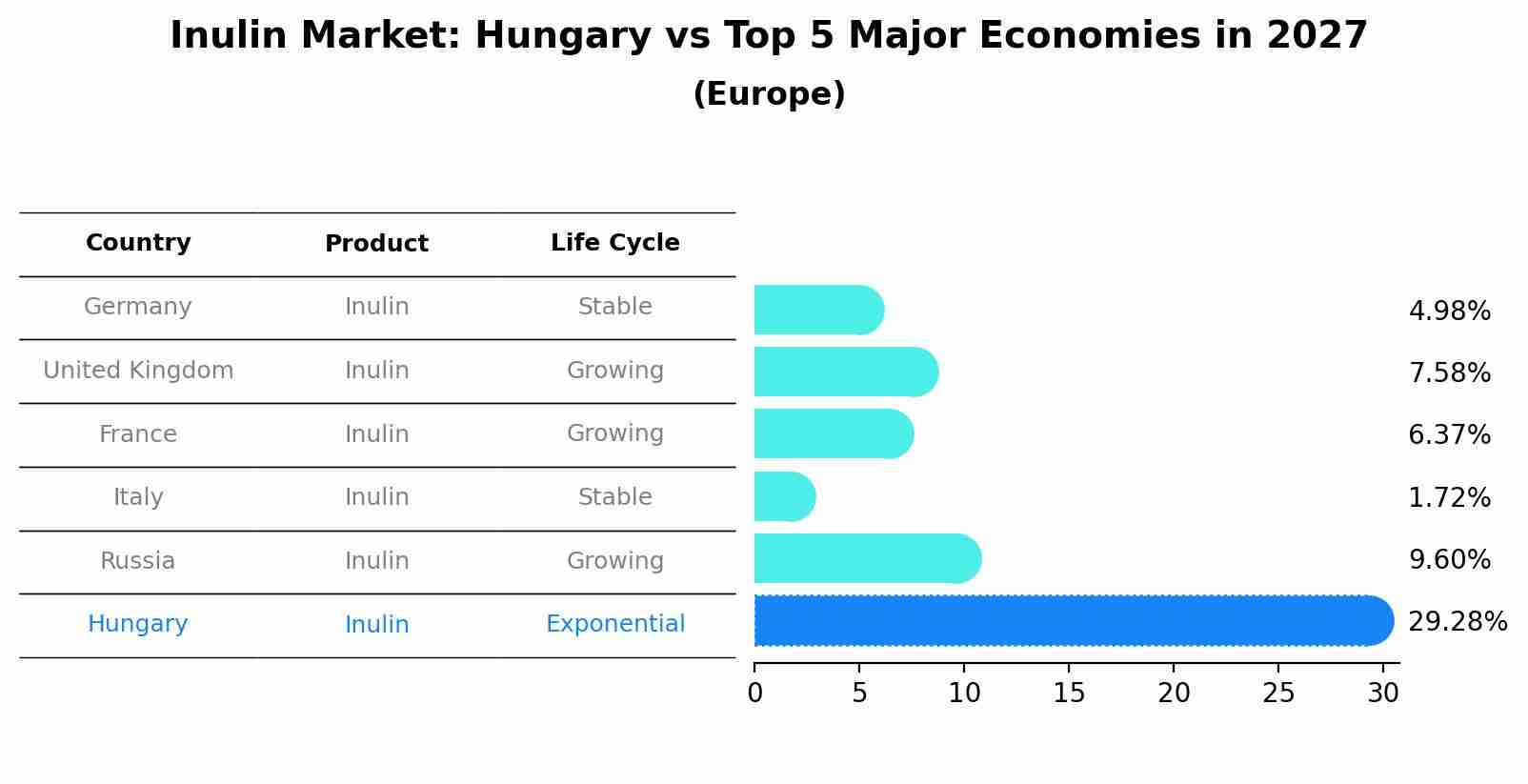Hungary Inulin Market | Growth, Size, Analysis, COVID-19 IMPACT, Forecast, Share, Revenue, Industry, Trends, Companies & Value
| Product Code: ETC179918 | Publication Date: Jan 2022 | Updated Date: Aug 2025 | Product Type: Market Research Report | |
| Publisher: 6Wresearch | No. of Pages: 70 | No. of Figures: 35 | No. of Tables: 5 | |
Hungary Inulin Market Size Growth Rate
The Hungary Inulin Market is projected to witness mixed growth rate patterns during 2025 to 2029. Starting at 5.80% in 2025, the market peaks at 29.28% in 2027, and settles at 9.14% by 2029.

Inulin Market: Hungary vs Top 5 Major Economies in 2027 (Europe)
By 2027, the Inulin market in Hungary is anticipated to reach a growth rate of 29.28%, as part of an increasingly competitive Europe region, where Germany remains at the forefront, supported by United Kingdom, France, Italy and Russia, driving innovations and market adoption across sectors.

Hungary Inulin Market Overview
Hungary inulin market is witnessing growth with the increasing demand for natural and functional food ingredients with prebiotic and dietary fiber properties. Inulin, sourced from chicory roots and other plants, offers digestive health benefits and sugar reduction properties, driving market demand for inulin-based food and beverage products.
Drivers of the market
Inulin is a soluble dietary fiber derived from plants such as chicory roots, offering various health benefits, including improved digestive health, blood sugar management, and weight control in Hungary food and beverage industry. The market is driven by factors such as consumer preferences for natural and functional ingredients, growing awareness about gut health, and demand for low-calorie and sugar-free products. As food manufacturers seek to develop healthy and indulgent products, there`s a growing demand for inulin as a versatile and functional ingredient in formulations such as dairy products, baked goods, and beverages, enabling the production of nutritious and flavorful offerings that meet evolving consumer needs and preferences.
Challenges of the market
A significant challenge in Hungary inulin market is educating consumers about its health benefits and applications. Despite its versatility as a dietary fiber and prebiotic, inulin remains relatively unknown to many consumers, requiring marketing efforts and nutritional education campaigns.
Government Policy of the market
Government policies in Hungary support the development and production of inulin as a functional food ingredient and dietary fiber supplement. Initiatives include research funding for inulin-based product development, regulatory support for health claims and labeling, and consumer education campaigns to promote the health benefits of inulin-rich foods and supplements.
Key Highlights of the Report:
- Hungary Inulin Market Outlook
- Market Size of Hungary Inulin Market, 2021
- Forecast of Hungary Inulin Market, 2028
- Historical Data and Forecast of Hungary Inulin Revenues & Volume for the Period 2018 - 2028
- Hungary Inulin Market Trend Evolution
- Hungary Inulin Market Drivers and Challenges
- Hungary Inulin Price Trends
- Hungary Inulin Porter's Five Forces
- Hungary Inulin Industry Life Cycle
- Historical Data and Forecast of Hungary Inulin Market Revenues & Volume By Form for the Period 2018 - 2028
- Historical Data and Forecast of Hungary Inulin Market Revenues & Volume By Powder for the Period 2018 - 2028
- Historical Data and Forecast of Hungary Inulin Market Revenues & Volume By Liquid for the Period 2018 - 2028
- Historical Data and Forecast of Hungary Inulin Market Revenues & Volume By Nature for the Period 2018 - 2028
- Historical Data and Forecast of Hungary Inulin Market Revenues & Volume By Organic for the Period 2018 - 2028
- Historical Data and Forecast of Hungary Inulin Market Revenues & Volume By Conventional for the Period 2018 - 2028
- Historical Data and Forecast of Hungary Inulin Market Revenues & Volume By Source for the Period 2018 - 2028
- Historical Data and Forecast of Hungary Inulin Market Revenues & Volume By Agave for the Period 2018 - 2028
- Historical Data and Forecast of Hungary Inulin Market Revenues & Volume By Chicory for the Period 2018 - 2028
- Historical Data and Forecast of Hungary Inulin Market Revenues & Volume By Jerusalem Artichoke for the Period 2018 - 2028
- Historical Data and Forecast of Hungary Inulin Market Revenues & Volume By Others for the Period 2018 - 2028
- Historical Data and Forecast of Hungary Inulin Market Revenues & Volume By Application for the Period 2018 - 2028
- Historical Data and Forecast of Hungary Inulin Market Revenues & Volume By Food & Beverages for the Period 2018 - 2028
- Historical Data and Forecast of Hungary Inulin Market Revenues & Volume By Dietary Supplements for the Period 2018 - 2028
- Historical Data and Forecast of Hungary Inulin Market Revenues & Volume By Pharmaceuticals for the Period 2018 - 2028
- Historical Data and Forecast of Hungary Inulin Market Revenues & Volume By Animal Feed for the Period 2018 - 2028
- Hungary Inulin Import Export Trade Statistics
- Market Opportunity Assessment By Form
- Market Opportunity Assessment By Nature
- Market Opportunity Assessment By Source
- Market Opportunity Assessment By Application
- Hungary Inulin Top Companies Market Share
- Hungary Inulin Competitive Benchmarking By Technical and Operational Parameters
- Hungary Inulin Company Profiles
- Hungary Inulin Key Strategic Recommendations
Frequently Asked Questions About the Market Study (FAQs):
1 Executive Summary |
2 Introduction |
2.1 Key Highlights of the Report |
2.2 Report Description |
2.3 Market Scope & Segmentation |
2.4 Research Methodology |
2.5 Assumptions |
3 Hungary Inulin Market Overview |
3.1 Hungary Country Macro Economic Indicators |
3.2 Hungary Inulin Market Revenues & Volume, 2021 & 2028F |
3.3 Hungary Inulin Market - Industry Life Cycle |
3.4 Hungary Inulin Market - Porter's Five Forces |
3.5 Hungary Inulin Market Revenues & Volume Share, By Form, 2021 & 2028F |
3.6 Hungary Inulin Market Revenues & Volume Share, By Nature, 2021 & 2028F |
3.7 Hungary Inulin Market Revenues & Volume Share, By Source, 2021 & 2028F |
3.8 Hungary Inulin Market Revenues & Volume Share, By Application, 2021 & 2028F |
4 Hungary Inulin Market Dynamics |
4.1 Impact Analysis |
4.2 Market Drivers |
4.2.1 Increasing consumer awareness about health benefits of inulin |
4.2.2 Growing demand for natural and functional food ingredients |
4.2.3 Rise in prevalence of lifestyle diseases leading to demand for low-calorie sweeteners |
4.3 Market Restraints |
4.3.1 Fluctuating prices of raw materials |
4.3.2 Stringent regulations regarding the use of inulin in food products |
5 Hungary Inulin Market Trends |
6 Hungary Inulin Market, By Types |
6.1 Hungary Inulin Market, By Form |
6.1.1 Overview and Analysis |
6.1.2 Hungary Inulin Market Revenues & Volume, By Form, 2018 - 2028F |
6.1.3 Hungary Inulin Market Revenues & Volume, By Powder, 2018 - 2028F |
6.1.4 Hungary Inulin Market Revenues & Volume, By Liquid, 2018 - 2028F |
6.2 Hungary Inulin Market, By Nature |
6.2.1 Overview and Analysis |
6.2.2 Hungary Inulin Market Revenues & Volume, By Organic, 2018 - 2028F |
6.2.3 Hungary Inulin Market Revenues & Volume, By Conventional, 2018 - 2028F |
6.3 Hungary Inulin Market, By Source |
6.3.1 Overview and Analysis |
6.3.2 Hungary Inulin Market Revenues & Volume, By Agave, 2018 - 2028F |
6.3.3 Hungary Inulin Market Revenues & Volume, By Chicory, 2018 - 2028F |
6.3.4 Hungary Inulin Market Revenues & Volume, By Jerusalem Artichoke, 2018 - 2028F |
6.3.5 Hungary Inulin Market Revenues & Volume, By Others, 2018 - 2028F |
6.4 Hungary Inulin Market, By Application |
6.4.1 Overview and Analysis |
6.4.2 Hungary Inulin Market Revenues & Volume, By Food & Beverages, 2018 - 2028F |
6.4.3 Hungary Inulin Market Revenues & Volume, By Dietary Supplements, 2018 - 2028F |
6.4.4 Hungary Inulin Market Revenues & Volume, By Pharmaceuticals, 2018 - 2028F |
6.4.5 Hungary Inulin Market Revenues & Volume, By Animal Feed, 2018 - 2028F |
7 Hungary Inulin Market Import-Export Trade Statistics |
7.1 Hungary Inulin Market Export to Major Countries |
7.2 Hungary Inulin Market Imports from Major Countries |
8 Hungary Inulin Market Key Performance Indicators |
8.1 Number of new product launches with inulin as an ingredient |
8.2 Consumer surveys indicating awareness and preference for products containing inulin |
8.3 Research and development investments in inulin-based product innovation |
9 Hungary Inulin Market - Opportunity Assessment |
9.1 Hungary Inulin Market Opportunity Assessment, By Form, 2021 & 2028F |
9.2 Hungary Inulin Market Opportunity Assessment, By Nature, 2021 & 2028F |
9.3 Hungary Inulin Market Opportunity Assessment, By Source, 2021 & 2028F |
9.4 Hungary Inulin Market Opportunity Assessment, By Application, 2021 & 2028F |
10 Hungary Inulin Market - Competitive Landscape |
10.1 Hungary Inulin Market Revenue Share, By Companies, 2021 |
10.2 Hungary Inulin Market Competitive Benchmarking, By Operating and Technical Parameters |
11 Company Profiles |
12 Recommendations |
13 Disclaimer |
- Single User License$ 1,995
- Department License$ 2,400
- Site License$ 3,120
- Global License$ 3,795
Search
Related Reports
- ASEAN Bearings Market (2025-2031) | Strategy, Consumer Insights, Analysis, Investment Trends, Opportunities, Growth, Size, Share, Industry, Revenue, Segments, Value, Segmentation, Supply, Forecast, Restraints, Outlook, Competition, Drivers, Trends, Demand, Pricing Analysis, Competitive, Strategic Insights, Companies, Challenges
- Europe Flooring Market (2025-2031) | Outlook, Share, Industry, Trends, Forecast, Companies, Revenue, Size, Analysis, Growth & Value
- Saudi Arabia Manlift Market (2025-2031) | Outlook, Size, Growth, Trends, Companies, Industry, Revenue, Value, Share, Forecast & Analysis
- Uganda Excavator, Crane, and Wheel Loaders Market (2025-2031) | Strategy, Consumer Insights, Analysis, Investment Trends, Opportunities, Growth, Size, Share, Industry, Revenue, Segments, Value, Segmentation, Supply, Forecast, Restraints, Outlook, Competition, Drivers, Trends, Demand, Pricing Analysis, Competitive, Strategic Insights, Companies, Challenges
- Rwanda Excavator, Crane, and Wheel Loaders Market (2025-2031) | Strategy, Consumer Insights, Analysis, Investment Trends, Opportunities, Growth, Size, Share, Industry, Revenue, Segments, Value, Segmentation, Supply, Forecast, Restraints, Outlook, Competition, Drivers, Trends, Demand, Pricing Analysis, Competitive, Strategic Insights, Companies, Challenges
- Kenya Excavator, Crane, and Wheel Loaders Market (2025-2031) | Strategy, Consumer Insights, Analysis, Investment Trends, Opportunities, Growth, Size, Share, Industry, Revenue, Segments, Value, Segmentation, Supply, Forecast, Restraints, Outlook, Competition, Drivers, Trends, Demand, Pricing Analysis, Competitive, Strategic Insights, Companies, Challenges
- Angola Excavator, Crane, and Wheel Loaders Market (2025-2031) | Strategy, Consumer Insights, Analysis, Investment Trends, Opportunities, Growth, Size, Share, Industry, Revenue, Segments, Value, Segmentation, Supply, Forecast, Restraints, Outlook, Competition, Drivers, Trends, Demand, Pricing Analysis, Competitive, Strategic Insights, Companies, Challenges
- Israel Intelligent Transport System Market (2025-2031) | Strategy, Consumer Insights, Analysis, Investment Trends, Opportunities, Growth, Size, Share, Industry, Revenue, Segments, Value, Segmentation, Supply, Forecast, Restraints, Outlook, Competition, Drivers, Trends, Demand, Pricing Analysis, Competitive, Strategic Insights, Companies, Challenges
- Uganda Precast and Aggregate Market (2025-2031) | Strategy, Consumer Insights, Analysis, Investment Trends, Opportunities, Growth, Size, Share, Industry, Revenue, Segments, Value, Segmentation, Supply, Forecast, Restraints, Outlook, Competition, Drivers, Trends, Demand, Pricing Analysis, Competitive, Strategic Insights, Companies, Challenges
- Australia IT Asset Disposal Market (2025-2031) | Strategy, Consumer Insights, Analysis, Investment Trends, Opportunities, Growth, Size, Share, Industry, Revenue, Segments, Value, Segmentation, Supply, Forecast, Restraints, Outlook, Competition, Drivers, Trends, Demand, Pricing Analysis, Competitive, Strategic Insights, Companies, Challenges
Industry Events and Analyst Meet
Our Clients
Whitepaper
- Middle East & Africa Commercial Security Market Click here to view more.
- Middle East & Africa Fire Safety Systems & Equipment Market Click here to view more.
- GCC Drone Market Click here to view more.
- Middle East Lighting Fixture Market Click here to view more.
- GCC Physical & Perimeter Security Market Click here to view more.
6WResearch In News
- Doha a strategic location for EV manufacturing hub: IPA Qatar
- Demand for luxury TVs surging in the GCC, says Samsung
- Empowering Growth: The Thriving Journey of Bangladesh’s Cable Industry
- Demand for luxury TVs surging in the GCC, says Samsung
- Video call with a traditional healer? Once unthinkable, it’s now common in South Africa
- Intelligent Buildings To Smooth GCC’s Path To Net Zero













